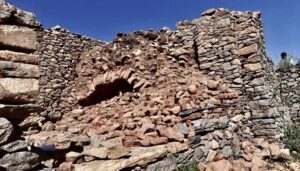
Abstract. War is a serious agent of destruction to cultural heritage. Primarily due to global attention to the Russia-Ukraine war, some have considered the war on the Tigray (also written as Tegray, Tigrai) a regional war less publicized but deadlier than the former. This deadlier war, backed by drone power actors, now passes two and a half years in duration. It is now documented that cultural predation, attacks on cultural heritage, territorial invasion, and ethnic cleansing have been committed in the Tǝgray region. Cultural heritage is highly affected primarily due to premeditated destruction campaigns. Tigray stands out for its archaeological, historical, and sacred heritage as a composite product of long-spanning civilizations. The author collected data via observation of some of the destroyed sites and from local and international media reports. The objective of this article is to alarm world heritage stakeholders that humanity is losing its legacy in one of its origin centers of civilizations, Tigray. The tactics of destruction include shelling and burning, the deliberate dismantling of contextual features, organized looting, pillaging, and littering of cultural heritage sites. Religious and non-religious, from the smallest objects like Axumite coins to larger monuments, both ancient and modern, were targeted. Locally, nationally, and internationally recognized cultural heritage or UNESCO-registered sites were damaged and looted. As the brutally occupied areas are freed , there will be more sites added to the list. Heritage organizations must be alarmed so that those responsible can intervene in the active destruction, and support post-war destruction assessment, repatriation and reconstruction.
Heritage Destruction and War
Although attacks on cultural heritage have caused international outrage, the international community´s understanding and action related to this severe global phenomenon is still limited. This scenario is worse in continents like Africa where micro conflicts, civil wars, and genocidal wars occur. Hence, it is easy to imagine the immensity of cultural heritage destruction in Africa.
Why do fighting parties target cultural heritage and what are the motives for attacking sites, buildings, or objects representing cultural heritage? This is an under-researched question. However, some researchers (see: Brosche et al., 2016) have sorted out:
“four motives and reasons for attacking cultural heritage: (i) attacks related to conflict goals, in which cultural property is targeted because it is connected to the issue the warring parties are fighting over; (ii) military strategic attacks, the main motivation for which is to win tactical advantages in the conflict; (iii) signaling attacks, in which cultural property is targeted as a low-risk target that signals the commitment of the aggressor; and (iv) economic incentives, where cultural property provides funding for warring parties.“
The world has already experienced much destruction. For example, in 2014 the Islamic State (IS) was seen deliberately damaging archaeological sites and museums, alongside its continued attacks on local shrines and holy places that are valued by the local communities. In the well-publicized news reports, prominent heritage sites and museums were reported to have been attacked or threatened with destruction (Harmansah, 2015).
Despite the global significance of cultural heritage and the immense destruction happening across the globe, comparatively little attention has been given to the issue. Though it is a fact that heritage destruction in wars is often unavoidable, it also matters if the damage is collateral damage, or intentional.
Cultural Heritage beyond Political Boundaries
Beginning in the late 2nd or early 1st millennium BC, human groups with different ceramic traditions emerged in the highlands of Hamasien near Asmara (north-central Eritrea), Akkele Guzay (south-central Eritrea), Agame (Eastern Tigray), and Central Tigray. Archaeological and textual evidence demonstrates that a polity, possibly at a state scale of complexity, arose in Tigray and Central Eritrea in the mid-1st millennium BC (Fattovich, 2010).
As a result of shared history, it is the same people within two different political boundaries, with a common art, architecture, sculpture, and inscription found up to the eastern side of the Red Sea, currently Yemen (Manzo, 2009). The people in Eritrea and Tigray share the pre-1991 history of ancient glory during the Da´amat Kingdom of 1000 BC, followed by the Aksumite polity in 1000 AD and the following periods.
Within the current Ethiopian state, because of the historical fact that the regional states of Tigray and Amhara are hubs and continuities of ancient civilizations, they make up many core parts of the Ethiopian empire/state.
As current political boundaries have less or almost nothing to do with the ancient realities and makeup, the cultural heritage, be it in Eritrea, Ethiopia’s Tigray, or Amhara, belongs to all humanity. The war on Tigray, however, demonstrates the reality that heritage in Tigray, regardless of its time and space, is a target for destruction during the Triangular war on Tigray
War of Joint Forces on Tigray and Heritage Destruction
Primarily due to global attention to the Russia-Ukraine war, some tend to call the war on Tigray (within Ethiopia) a hidden but deadlier war than the former. This deadly, unjust, and asymmetrical war backed by drone power actors now marks two years. Experts use different terms for the war: at the beginning it was a genocide in the making, with some warning of only a narrow window of genocide prevention; others, that a genocide is happening in Tigray. In fact, genocide is a legal term.
Considering the close to one million combatants and brutality seen in the war, some have called it a war with World War I style tactics, or an intentional long-range weapon shelling and aerial attacks on churches, cities, and villages; a war against all (history, memory, territory and people); a war with a scorched-earth policy; a vicious, drawn-out war, or war that is motivated by hatred to people; a policy aiming to decimate historical nationhood of the de jure Tigray regional state. These are the phrases used by international commentators and experts to describe it.
Destruction of monuments and sites erases history and causes irreparable harm to the cultural and religious identities of people around the world. As cultural heritage is inextricably linked to a certain society, there is a connection between cultural cleansing and mass atrocities. Commitments that failed to prevent genocide, war crimes, ethnic cleansing, and crimes against humanity are direct failures in cultural heritage protection, as well. Edward C. Luck in his Cultural Genocide and the Protection of Cultural Heritage regrets that framing heritage attacks as cultural genocide could have helped more. Protecting cultural heritage, therefore, may prevent or deter genocide. Destroying cultural heritage is an attack on humanity’s past and present. Despite the ‘never genocide again’ slogans of the Western world, in Tigray neither is prevented. In addition, destruction of cultural heritage fuels the causes of war; avoiding it could indeed have helped minimize tensions and aggressions.
In the war on Tigray, as documented by internationally famed organizations, cultural predation, attacks on cultural heritage, territorial invasion, forced assimilation, and ethnic cleansing are committed by the joint Ethiopia, Eritrea, and local Amhara forces on the Tigrayan population. In addition to the already created humanitarian Armageddon and loss of close to 10% of the Tigray population, cultural heritage has been highly adversely affected, primarily due to premeditated destruction campaigns. It is particularly tragic because embattled Tigray stands out for its archaeological, historical, and sacred heritage, as well as traditions and values as a composite product of long-spanning (ca. 4,000 years) civilizations.
The International Council on Monuments and Sites (ICOMOS) on March 5th, 2021, voiced its alarm about news of intentional cultural cleansing in Tigray. Artifacts, manuscripts, books, museums, and other religious and cultural treasures from churches have been looted and pillaged throughout the region’s long and rich history as spoils of historical war. The current heritage destruction, however, is the worst and most monumental one. Foreign heritage experts warned and local individuals and organizations have reported and published the destruction in different ways. Much of the evidence of destruction has been leaked and seen circulating on social media, as the region was in total communications blackout.
In April 2022, the International Society, Heritage Society of Tigray fiercely condemned all human rights abuses and heritage crimes committed in Tigray, calling on the international community and responsible bodies to plan an urgent intervention to protect, salvage, and restore Tigray’s cultural heritage (Hest, 2022).
______________________________
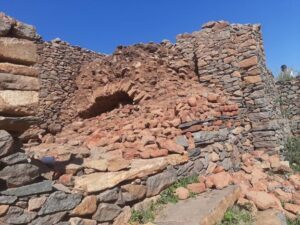
Above and below: Dngur, an Aksum palace of 6th century AD walls and its brick feature collapsed (source: Hiyab Gebretsadik, 2021).
______________________________
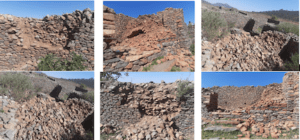
Dgrur palace Axum after destruction.
______________________________
************
The author, despite the limitations from the communication blackout in Tigray, has collected data via observation of some of the destroyed sites and from local and international media outlet reports. The objective is to warn global heritage stakeholders that humanity is losing a legacy in an important area of civilization origins — Tigray. This article focuses on the affected tangible cultural heritage objects and monuments.
The destruction tactics include shelling and burning, the deliberate dismantling of contextual features, organized looting, pillaging, burning, and littering of cultural heritage. As a result, different types of cultural heritage have been adversely affected to various degrees. Religious (Orthodox, Catholic, and Islam) and non-religious, from the smallest objects like Aksumite (4th c AD) coins, to monuments, as well as historical and archeological museums, have been targeted. Prime examples follow:
Al-Nejashi Mosque
Al-Nejashi mosque is an iconic heritage, cherished by Tigrayans for being a symbol of Tigray’s religious symbiosis (or coexistence). It was first bombed and later looted by the Ethiopian and Eritrean troops in December 2021. The mosque’s minaret was destroyed; its dome partially collapsed and its façade is in ruins; inside the mosque, rubble from the collapse is seen littered on the floor; a number of old holy manuscripts and books were looted; a shrine believed to contain the remains of followers of the prophet Mohammed is also damaged and littered.
______________________________
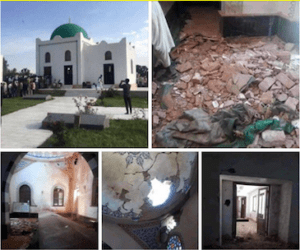
Al-nejashi mosque dome partially collapsed; its façade in ruins; rubble littering the floor (source: Tǝgray Televison). Locally, nationally, and internationally recognized cultural heritage sites or UNESCO-registered sites were damaged and looted.
______________________________
Mai adrasha, Shire, Northwestern Tigray
The site of mai adrasha in Shire is damaged due to the war and its crisis. Tragically, the archaeological finds storeroom in the regional administrative office is 100% damaged and burnt by both Eritrean and Ethiopian forces as part of the war. A quoted statement below explains in detail:
“Excavated finds from Mai Adrasha have been dated back to 1250 BCE, making it the oldest site in northern Ethiopia. All finds were washed, documented, catalogued and analyzed, after which they were stored in a room in the regional administrative building. In December 2020 this building was bombed by Ethiopian and Eritrean forces. As you can see in the pictures, the shelves are now empty and all boxes thrown to the ground. Later, some of the local people took the opportunity to visit the storeroom and further damage the boxes. Not a single box is now in a good condition; every box is destroyed and most of the finds are broken, some of them stomped into dust.” (Barnardand Wendrich 2022: 53).
_____________________________

The store room of the UCLA project in the regional administrative office in shire indasilasie in August 2021 (source: Barndard and wendrich 2022)
_____________________________
Churches and Monasteries
Around 30 churches and monasteries (6th c AD—19th c AD) were severely damaged and destroyed. Thousands of objects have been looted. Some of the looted objects appeared on the antiquities market, including e-Bay.
______________________________
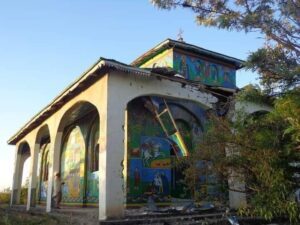
Destroyed churches: Saint George Church in Adi Daero (Source: Hadgi Tǝgray facebook)
______________________________
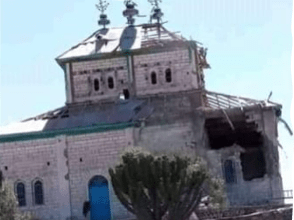
Church of Qirqos Liga´at in Northeastern Tigray (Source: Negasi Awetehey)
______________________________
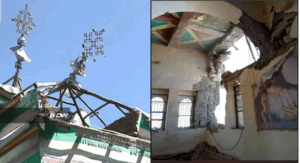
Destroyed church of Debre Medhanit, Amanuel Ma‘go (source: Dimtsi Weyane TV).
______________________________
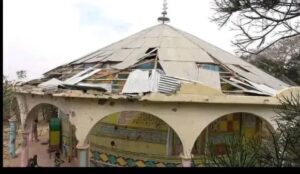
A church in Adiabo (northwestern Tigray)
______________________________
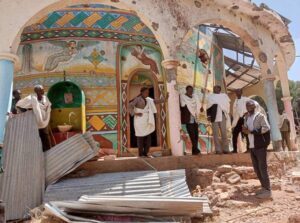
A church in Adiabo (northwestern Tigray)
______________________________
Walduba Monastery
Walduba monastery is a 14th-century monastery located in Western Tigray. As the nuns and monks told local media, the joint armies looted over 3,000 parchment manuscripts and over 300 ancient crosses made of gold and silver, burned and littered many other religious treasures, and destroyed the church museum. The destruction goes beyond the physical destruction — it is a grand loss of human history and wisdom.
Debre Damo Monastry
Debre Damo is a renowned 6th-century monastery, the first monastery in Sub-Saharan Africa located on a plateau in Eastern Tigray. It is home to a rich collection of manuscripts and known for retaining Aksumite and Pre-Aksumite art and architecture. It was reported to have been bombed, with buildings damaged. More than five Eritrean soldiers were reported to have climbed up to the monastery and vandalized it (Hagos, 2022).
A Call to Humanity
The destruction, sadly internationally overlooked, has painful consequences and is a great loss of cultural heritage. The case of cultural heritage destruction in Tigray is the epitome of intentional attacks of heritage during war. Based on the provisions of the “Policy Document for the Integration of a Sustainable Development Perspective into the Processes of the World Heritage Convention” (UNESCO, 2015) and a draft policy of the International Criminal Court (ICC, 2021), the safeguarding of cultural heritage is a fundamental human right. UNESCO Convention 1972 also states that State governments (e.g. Ethiopia) have the responsibility to protect heritage found within their boundaries. But the case in Ethiopia is an irony and international organizations like UNESCO, ICOM, INTERPOL, and Blue Shield International have yet to address these crimes. Important cultural heritage is compromised.
The author calls on the international community to raise global awareness of the tragic issue, and to support the “post-war“damage and destruction assessment, as well as reconstruction and repatriation.
_______________________________
References
Abbay, A.: Diversity and State-Building in Ethiopia. African Affairs 103(413): 593–614 (2004).
Alemseged A.: Identity Jilted or Re-imagining Identity? The divergent paths of the Eritrean and Tigrayan nationalist struggles. Red Sea Press, Trenton NJ (1998).
Barnard Hans and Wendrich Willeke: The Forgotten War in Tigray, Northern Ethiopia. BackDirt, ANNUAL REVIEW OF THE C OTSEN INSTITUTE OF ARCHAEOLOGY AT UCLA (December 2022).
Johan Brosché, Mattias Legnér, Joakim Kreutz & Akram I.: Heritage under attack: motives for targeting cultural property during armed conflict. International Journal of Heritage Studies, (2016).
Fattovich, R.: The Development of Ancient States in the Northern Horn of Africa, c. 3000 BC—AD 1000: An Archaeological Outline. Journal of World Prehistory 23 (3): 145–75 (2010).
Harmanşah, Ö.: ISIS, Heritage, and the Spectacles of Destruction in the Global Media. Near Eastern Archaeology 78(3), 170–77 (2015).
Heritage Society of Tigray (Hest): Heritage society of Tigray Condemns the Cleansing of Tigray’s Heritage. Statement Released on April, 2022.
Phillipson, D. W. : Foundations of an African civilization: Aksum & the northern Horn 1000 BC-AD 1300. James Currey, Woodbridge (2012).
Plaut, Martin, Helen Clark, Habte Hagos, Kjetil Tronvoll, Teka Ergonomics, Felicia Mulford, Sally Keeble, Araya Debessay, and Hagos Abrha Abay. 2022. The Tigray War and Regional Implications (Volume 2). https://www.academia.edu/ 71580104/The_Tigray_War_and_Regional_Implications_Volume_2_Final . Last consultation on 19/02/2023.
Manzo, A.: Capra Nubiana in Berbere Sauce? Pre-Aksumite Art and Identity Building. African Archaeological Review 26 (4): 291-303 (2009).
In Tigray’s war, ancient Christian and Muslim houses of worship are increasingly under attack. theglobeandmail.com/world/article-in-tigrays-war-ancient-christian-and-muslim-houses-of-worship-risk/




